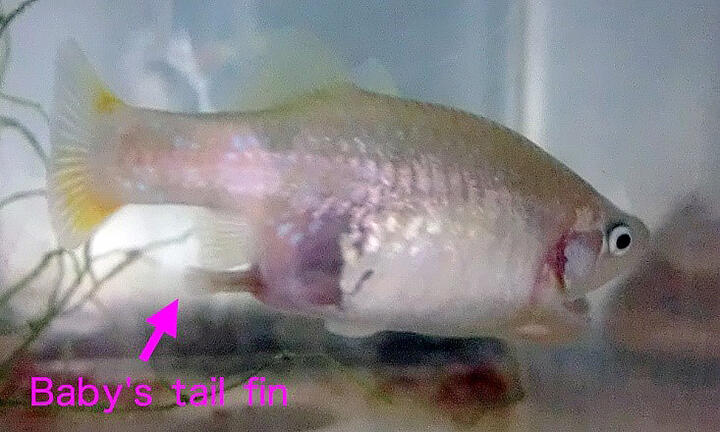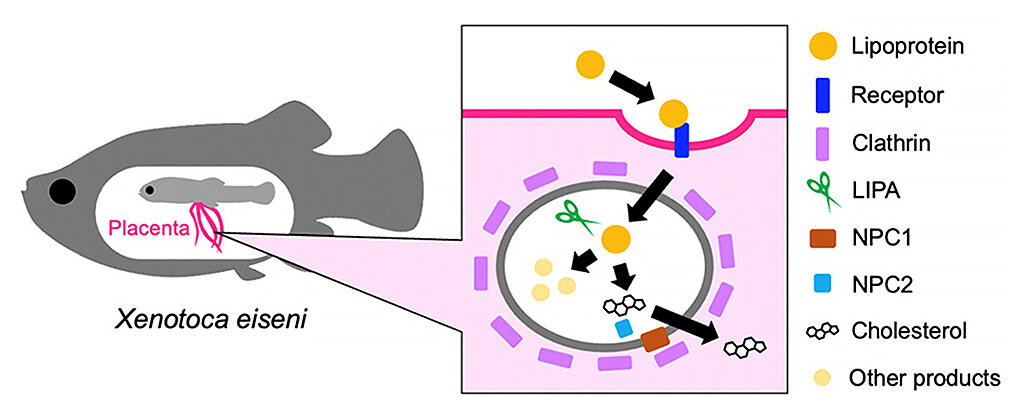A research group consisting of Assistant Professor Atsuo Iida and Professor Eiichi Hondo, Graduate School of Bioagricultural Sciences, Nagoya University, and their colleagues has announced that, together with Osaka City University and Tohoku University, they have clarified how non-mammalian viviparous animals deliver nutrients from mother to offspring in the redtail splitfin (Xenotoca eiseni), a species of viviparous fish. It has become clear that redtail splitfin embryos absorb proteins and lipids through endocytosis in the cells of an organ known as the trophotaenia, which acts as a placenta attached to the embryo. It is hoped that this outcome will lead to an understanding of the mechanism behind fish being viviparous. The group's research results were published in the June 3 edition of Biochimica et Biophysica Acta - Molecular and Cell Biology of Lipids, an international science journal.

Provided by Nagoya University
Redtail splitfins belong to the Goodeidae family (order: Cyprinodontiformes). They are freshwater fish native to Central America, and, unlike many fish species, are viviparous: their young are born as fry. Viviparity is not common among fish, but it is known that it has evolved independently among many vertebrates.
In the past, research groups have studied the structure of non-mammalian placentas and the molecular mechanism of nutrient transmission using redtail splitfins as an experimental model. Goodeidae embryos, including those of redtail splitfins, have a structure (the trophotaenia) that extends outside the body from the area around the anus, and it is thought that this is the placenta that absorbs nutrients originating from the uterus. The trophotaenia is tissue attached to the embryo, and a partial continuation of the intestine. There is no bond or adhesion to any tissues of the mother, and it is almost completely destroyed through apoptosis before birth. Researchers have also learned that vitellogenin (the egg-yolk protein) is included in the nutrients provided from the mother's body. Mammals do not have this protein.
Based on systematic observation of the trophotaenia and genetic expression, this research group believed that vitellogenin absorption occurs through endocytosis and carried out experiments to verify this. More specifically, they observed whether artificially administered labeled vitellogenin molecules were absorbed through endocytosis via the trophotaenia. They also investigated whether vitellogenin is absorbed when clathrin molecules associated with endocytosis are inhibited. When they did so, they found that vitellogenin is absorbed through clathrin-dependent endocytosis in the trophotaenia.
The group also explored genetic expression and protein distribution to investigate lipid metabolism mechanisms after absorption. The results indicated the presence of a series of gene expression pathways connected to digestion, and the existence of a transport mechanism involving lipid degradation and degradation products (cholesterol), etc., in the cells of the trophotaenia. This has illuminated the possibility that the trophotaenia is tissue derived from the alimentary canal. From these results, the group also proved that the trophotaenia is a placenta from the perspective of molecular biology. A placenta is defined as an organ that connects an embryo to the mother's body.

Provided by Nagoya University
Assistant Professor Iida commented, "In the future, we want to explore the sequence of events involved in redtail splitfin pregnancy and what determines the timing of their births, and clarify the deciding factors involved. Redtail splitfin pregnancies last around five weeks, but we have observed that this can change due to stress. We'd like to clarify whether the deciding factor lies with the mother or the embryo, and also how the mechanism is controlled in terms of molecular biology."
Journal Information
Publication: Biochimica et Biophysica Acta - Molecular and Cell Biology of Lipids
Title: Endocytosis-mediated vitellogenin absorption and lipid metabolism in the hindgut-derived placenta of the viviparous teleost Xenotoca eiseni
DOI: 10.1016/j.bbalip.2022.159183
This article has been translated by JST with permission from The Science News Ltd.(https://sci-news.co.jp/). Unauthorized reproduction of the article and photographs is prohibited.




